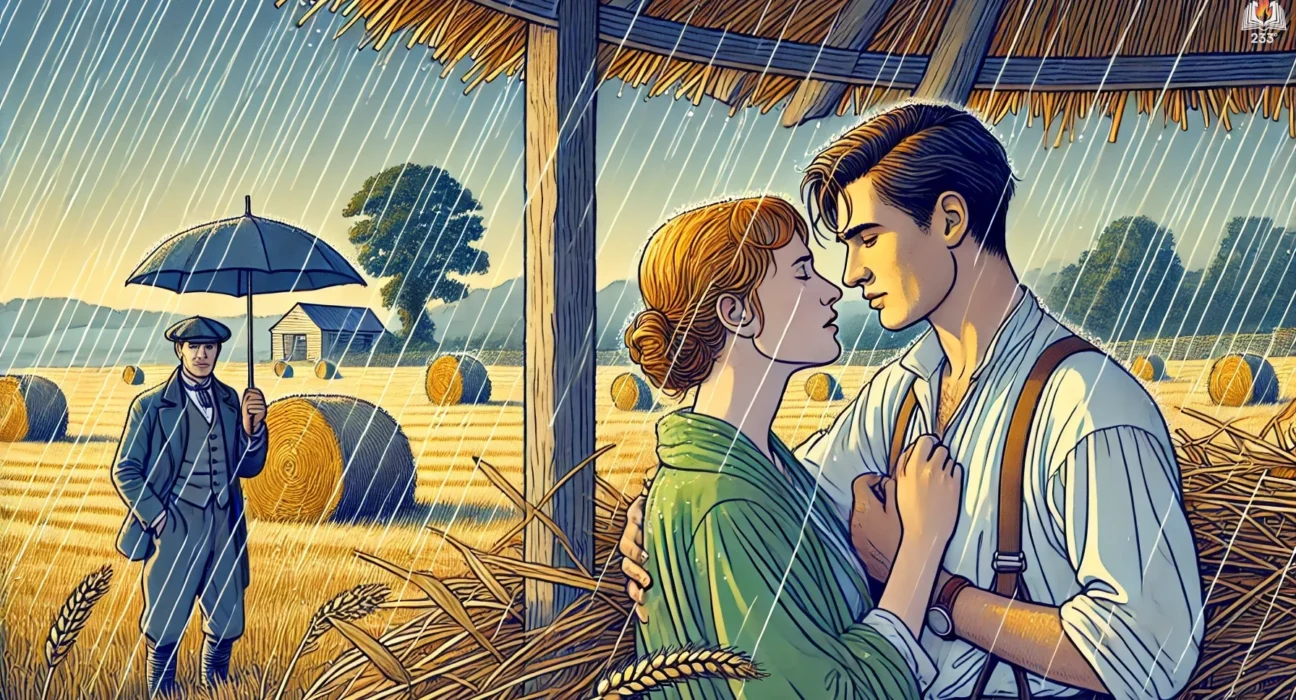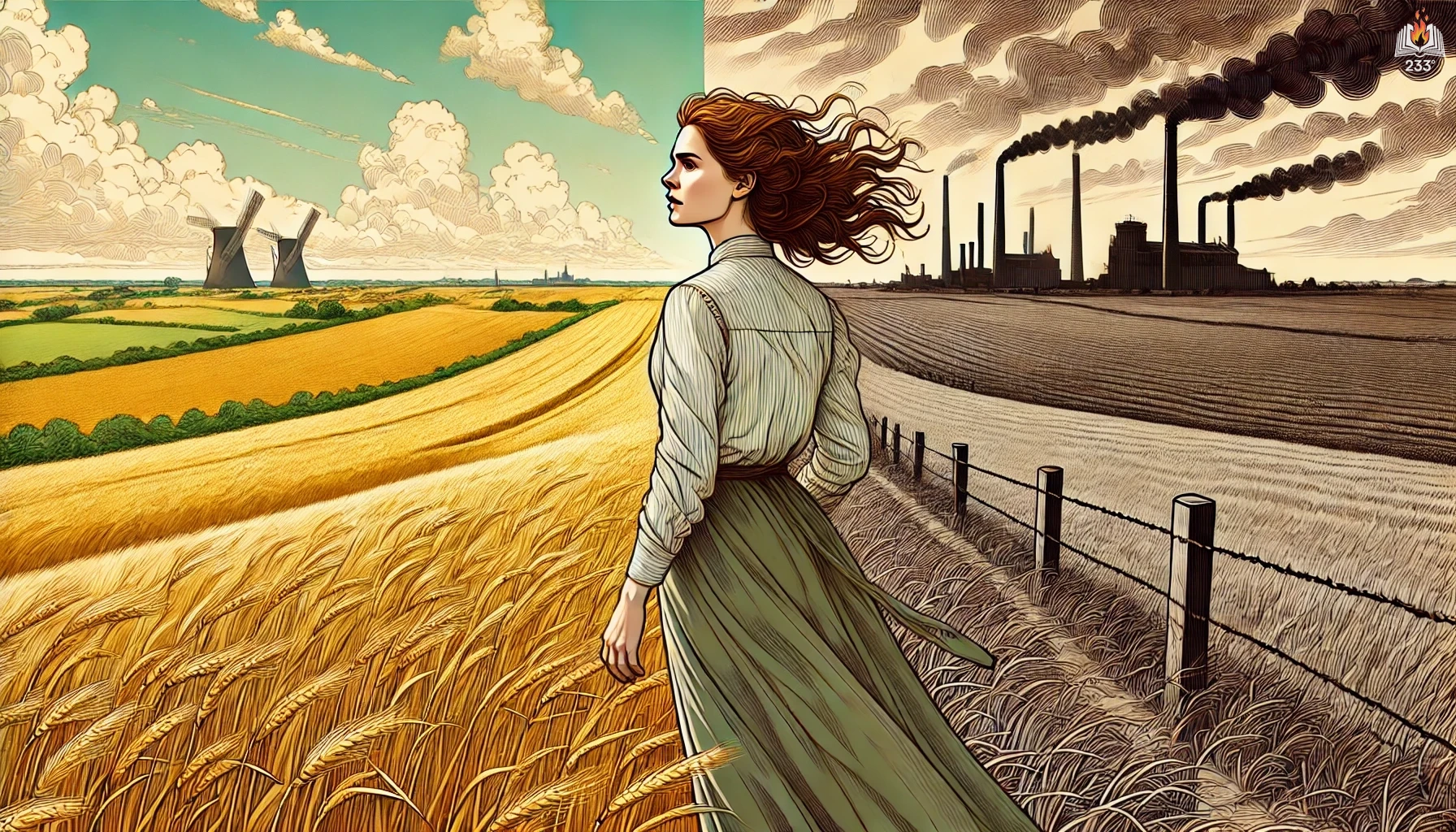Love Among the Haystacks, written by D.H. Lawrence and published posthumously in 1930, is a short story that reflects Lawrence’s themes of emotional intensity, sexuality, and rural life. Set in the English countryside, the story follows two brothers, Maurice and Geoffrey Wookey, as they experience emotional turbulence during a hay-harvesting season, revolving around themes of love, desire, and self-realization.
Plot Summary
The fields lay golden under the summer sun, freshly cut and dotted with haystacks that climbed like towers toward the sky. The Wookey brothers, Maurice and Geoffrey, paused in their work, wiping the sweat from their brows, silently bound by the labor of the day. They worked on their father’s farm, far from the bustling towns, surrounded only by the quiet fields and the weight of their unspoken feelings.
Maurice, the younger of the two, was full of youthful energy and charm. His face, sun-tanned and smiling, betrayed a certain restlessness, a yearning that had yet to find its shape. He was handsome, bold, and eager for life’s pleasures, but his emotional depth was still untested. Geoffrey, by contrast, was heavier, more brooding. His hulking frame was weighed down not just by the hay but by the invisible burden of his insecurities. He was shy, awkward, and less confident than his brother when it came to the world of women and emotions. Inside, he battled with a storm of envy and self-doubt.
As the two brothers stacked the hay under the relentless sun, they noticed a movement on the hill. Paula Jablonowsky, the young German governess from the Vicarage, appeared with a bright smile and a wave. Maurice’s heart stirred. He had spoken to her before, and their exchanges had been light and teasing, filled with the promise of something more. She was different from the local girls—lively, foreign, and full of an untamed energy that both brothers found irresistible.
Maurice had already kissed Paula once, a stolen moment in the moonlight that haunted his every thought. His excitement over that night boiled within him, and now he was eager to see her again. Paula, with her golden hair and mischievous smile, held a magnetic pull over him. She made him feel powerful and alive in a way he had never experienced before. But Geoffrey watched these interactions with darkening eyes, his heart bitter with jealousy. He, too, had noticed Paula, but her attentions were for Maurice, not him. As Maurice laughed and flirted with her, Geoffrey’s anger simmered just below the surface.
One evening, when the family and laborers gathered for their evening meal, Paula approached Maurice with a special plate of chicken, her gesture as obvious as the flush on his face. Everyone laughed, but Geoffrey’s chest tightened with a mix of anger and helplessness. He was always on the outside, watching Maurice effortlessly charm the world around him. He wanted that kind of power over people, especially over a woman like Paula, but it seemed impossible. The two brothers, though close, were now divided by a silent rivalry, a competition neither had spoken of but both understood.
After the meal, the tension between the brothers escalated as they worked side by side on the haystack. Geoffrey, filled with resentment, threw his hay with deliberate carelessness, forcing Maurice to work harder. The heat of the day combined with the heat of their anger. Finally, their frustration boiled over, and Maurice confronted his brother, pushing Geoffrey’s patience to the breaking point. In a sudden outburst, Geoffrey shoved Maurice, and the younger brother lost his balance, tumbling off the edge of the haystack.
For a brief, terrible moment, Geoffrey stood frozen, his heart pounding as he feared the worst. Had he killed his brother? But soon enough, Maurice stirred, bruised but alive, leaving Geoffrey relieved yet hollow. The guilt of his jealousy weighed heavily on him, but it was nothing compared to the self-loathing that followed. Maurice’s near fall became a symbol of how far they had drifted apart, and how dangerous their rivalry could become.
As evening fell, Maurice and Paula met in secret, under the cover of the darkening sky. Paula, with her free spirit and fierce energy, was drawn to Maurice’s open-hearted nature, and together, they shared a connection that felt new and thrilling to them both. They laughed, ran through the fields, and in a daring moment, Maurice hoisted her onto a horse, and together they rode bareback across the moonlit hills. The exhilaration of their ride reflected the wild emotions bubbling inside them. Paula, holding tight to Maurice, felt a sense of freedom she had never known. For Maurice, this was more than excitement; it was his awakening, a realization that love and desire could transform him.
Back at the farm, Geoffrey watched them from a distance, his loneliness gnawing at him. He felt invisible, a shadow in the background of his brother’s life. His envy deepened into despair as he slouched alone, unable to reach the intimacy that Maurice so easily shared with Paula. The sight of them together was a reminder of everything he lacked: confidence, charm, and the ability to be loved.
Rain began to fall, lightly at first, then harder. Maurice and Paula, caught in the storm, rushed to the stacks to cover the hay with a large cloth. They worked together in the darkness, their bodies close, their breath mingling. When the work was done, they sheltered under the cover, the intimacy of the moment electrifying. Maurice, nervous yet emboldened, reached for Paula, and they kissed, their passion igniting in the warm, rain-soaked air.
Meanwhile, Geoffrey sought refuge in a nearby shed, tormented by the thought of his brother and Paula together. His mind raced with jealousy, bitterness, and longing. As the rain beat against the roof, Geoffrey’s isolation felt complete. He was trapped, not just in the shed, but in his own emotional prison, unable to break free.
The storm outside mirrored the tempest within each of the brothers. Maurice, caught up in his first experience of love, felt an exhilarating sense of transformation, while Geoffrey, trapped in his bitterness, sank deeper into a despair that threatened to consume him. The haystacks, the fields, the rain—everything around them seemed to pulse with the intensity of their emotions.
As dawn approached, the world outside seemed refreshed by the night’s rain, but inside the Wookey brothers, the seeds of conflict and desire had only just begun to take root. For Maurice, the world was opening up in ways he had never imagined. For Geoffrey, it was closing in, leaving him more alone than ever before.
Main Characters
Maurice Wookey: The younger of the two brothers, Maurice is more carefree, adventurous, and expressive in his emotions. He is quick to explore new romantic and physical experiences and has a light-hearted, playful demeanor. Throughout the story, Maurice evolves as he navigates his first experience of love, excitement, and passion.
Geoffrey Wookey: Geoffrey, Maurice’s older brother, is more serious and introverted. He suffers from feelings of insecurity and loneliness, especially as he struggles with his own shyness around women. His character’s journey reflects deeper emotional turmoil, dealing with jealousy, resentment, and a lack of fulfillment.
Paula Jablonowsky: A young, lively, and passionate German governess who works at the local Vicarage. She is the object of both brothers’ affections, particularly Maurice’s, and represents a free-spirited woman who is confident in her emotions and desires. Paula’s presence stirs the brothers’ emotions and conflicts.
The Wookey Father: A practical farmer and the father of Maurice and Geoffrey, he represents the stable, grounded figure in the story, though his role is more in the background.
Theme
Sexual Awakening: Lawrence is known for his focus on sexuality, and Love Among the Haystacks explores the awakening of Maurice and Geoffrey to the complexities of sexual desire. Maurice’s first romantic encounters with Paula bring feelings of excitement, while Geoffrey’s suppressed emotions lead to envy and internal conflict.
Jealousy and Rivalry: The story highlights sibling rivalry, especially as Geoffrey becomes jealous of Maurice’s success with Paula. Geoffrey’s emotional volatility escalates as he feels left out and inferior, which eventually leads to dangerous tensions between the brothers.
Rural Life and Nature: The vivid descriptions of the English countryside, particularly the hayfields and stacks, serve as both the backdrop and a metaphor for the characters’ emotions. The landscape mirrors the growth and intensity of their passions, with the natural setting being almost another character in the story.
Loneliness and Isolation: Geoffrey’s character embodies the theme of loneliness, as he feels disconnected from the women around him and struggles with his inability to express his emotions freely. His isolation is contrasted by Maurice’s more open and successful emotional journey.
Writing Style and Tone
D.H. Lawrence’s writing style in Love Among the Haystacks is characterized by rich, descriptive language that paints the rural landscape with vivid detail, making the setting feel alive and resonant with the emotions of the characters. His prose is immersive, often blending the psychological states of the characters with the physical environment. The sensory details—smell, sight, and sound—are strongly evoked, particularly in descriptions of the hayfields, sunlight, and weather.
The tone of the story is one of emotional tension and introspection. Lawrence delves deep into the psychological states of his characters, using a reflective and almost brooding tone when exploring Geoffrey’s internal struggles, while Maurice’s experiences are captured with a more youthful and optimistic energy. There is a strong sense of realism, but Lawrence also weaves in elements of natural symbolism to highlight the characters’ inner journeys. The tone shifts between moments of lightness, passion, and darker, more brooding reflections on jealousy and inadequacy.
We hope this summary has sparked your interest and would appreciate you following Celsius 233 on social media:
There’s a treasure trove of other fascinating book summaries waiting for you. Check out our collection of stories that inspire, thrill, and provoke thought, just like this one by checking out the Book Shelf or the Library
Remember, while our summaries capture the essence, they can never replace the full experience of reading the book. If this summary intrigued you, consider diving into the complete story – buy the book and immerse yourself in the author’s original work.
If you want to request a book summary, click here.
When Saurabh is not working/watching football/reading books/traveling, you can reach him via Twitter/X, LinkedIn, or Threads
Restart reading!








